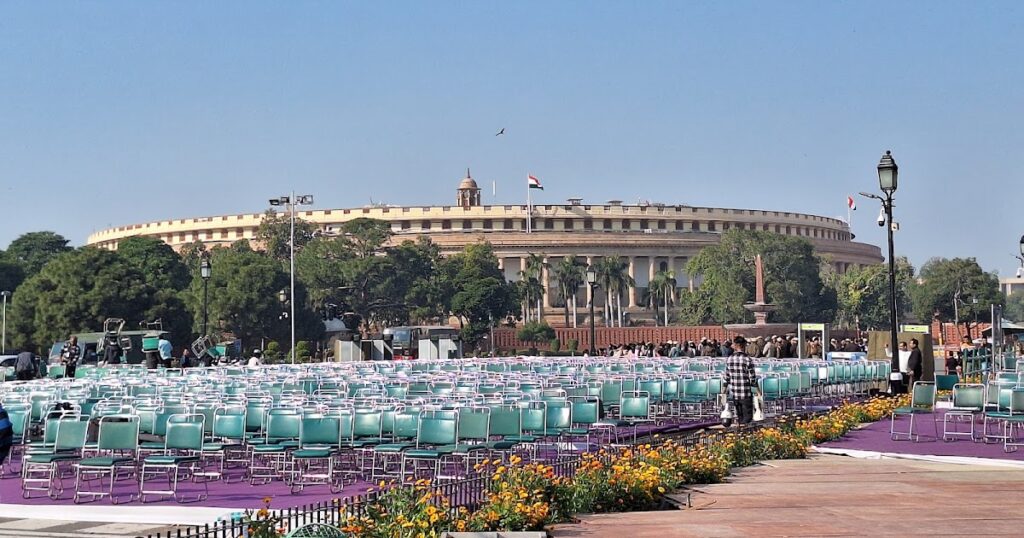Long before the modern Parliament House came into being, India’s legislative activities were centered in a magnificent circular building in New Delhi. Known today as the Old Parliament House, this iconic structure stood witness to colonial rule, India’s hard-earned independence, and the growth of the world’s largest democracy for nearly a century.
Even after the inauguration of the new Parliament building in 2023, the old circular structure remains an important symbol of India’s political journey.
Historical Background
The Old Parliament House was originally called the Council House during British rule. It was built as part of the new capital city of Delhi, following the Delhi Durbar of 1911, where the British announced the transfer of India’s capital from Calcutta to Delhi.
-
Foundation Stone: Laid in 1921
-
Inaugurated: 18 January 1927
-
Architects: Sir Edwin Lutyens and Sir Herbert Baker
-
Original Purpose: Seat of the Imperial Legislative Council
After India gained independence in 1947, the building became the home of the Constituent Assembly, which drafted the Constitution of India. From 1950 onwards, it functioned as the official Parliament of India, housing both the Lok Sabha and Rajya Sabha, until it was retired in May 2023.
 |
| A wide-angle view of the Old Parliament House in Delhi, showcasing its circular architecture—an enduring legacy of early 20th-century imperial design |
Architectural Features
The building’s architecture is a harmonious blend of Western classicism and Indian tradition.
Notable Features:
-
Shape: A perfect circle, 170 meters in diameter, with a large open courtyard at its center.
-
Colonnade: A graceful outer ring of 144 sandstone columns, each 27 feet high.
-
Chambers: Three semicircular chambers inside—originally for the Council of State, Central Legislative Assembly, and the Library.
-
Materials: Red and cream sandstone sourced from Dholpur and Fatehpur Sikri.
The central dome, though less prominent than that of Rashtrapati Bhavan, adds balance and elegance to the structure. The design also includes decorative railings, chhajjas, and motifs inspired by Buddhist stupas and Mughal architecture.
A Temple That Echoes in Design
An often-discussed theory links the circular design of the Old Parliament House to the ancient Chausath Yogini Temple in Mitaoli, Madhya Pradesh. Built in the 11th century CE, this temple features a unique circular layout with 64 small shrines arranged around a central sanctum. While the Parliament was officially designed by Sir Edwin Lutyens and Herbert Baker with no recorded attribution to Indian temples, the visual similarity between the two structures is striking. This resemblance has led many to speculate that India’s millennia-old temple architecture might have subconsciously influenced even colonial-era design decisions—blending form, symbolism, and spatial planning across centuries.
Role in India’s Democratic History
The Old Parliament House is more than a colonial relic—it is a stage upon which India’s destiny was reshaped.
-
It was here that Jawaharlal Nehru delivered his famous “Tryst with Destiny” speech on the eve of independence.
-
The building housed the Constituent Assembly, where India’s Constitution was drafted and adopted.
-
For decades, it witnessed spirited debates, landmark legislations, and historical speeches from leaders like Dr. B.R. Ambedkar, Indira Gandhi, Atal Bihari Vajpayee, and many others.
Even moments of political crisis, like the Emergency (1975–77), played out within these circular walls.
Current Status and Future Plans
In May 2023, parliamentary sessions were shifted to the new Parliament building, situated adjacent to the old one. The old structure has since been renamed as “Samvidhan Sadan”, meaning Constitution House.
It will now be preserved as a museum of democracy, housing:
-
Historical documents and exhibits
-
Digital archives of debates and laws
-
Guided tours explaining India’s parliamentary journey
The government has assured that the structure will be maintained with utmost care, as a tribute to the democratic legacy it embodies.
The Old Parliament House is not just an architectural marvel; it is a monument to India’s democratic evolution. From British imperial control to independent India’s governance, it has been a silent witness to change, continuity, and the spirit of the Constitution. As it steps into its new role as a museum, its legacy will continue to inspire generations.
Happy travelling.

